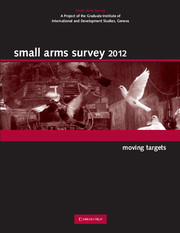Book contents
- Frontmatter
- Foreword
- Contents
- About the Small Arms Survey
- Notes to readers
- Acknowledgements
- Introduction
- Chapter 1 A Fatal Relationship: Guns and Deaths in Latin America and the Caribbean
- Chapter 2 When Business Gets Bloody: State Policy and Drug Violence
- Chapter 3 A Matter of Survival: Non-lethal Firearm Violence
- Chapter 4 Blue Skies and Dark Clouds: Kazakhstan and Small Arms
- Chapter 5 Between State and Non-state: Somaliland's Emerging Security Order
- Photo Essay. Troubled Waters: Somali Piracy
- Chapter 6 Escalation at Sea: Somali Piracy and Private Security Companies
- Chapter 7 Precedent in the Making: The UN Meeting of Governmental Experts
- Chapter 8 Piece by Piece: Authorized Transfers of Parts and Accessories
- Chapter 9 Point by Point: Trends in Transparency
- Chapter 10 Surveying the Battlefield: Illicit Arms in Afghanistan, Iraq, and Somalia
- Index
Chapter 6 - Escalation at Sea: Somali Piracy and Private Security Companies
Published online by Cambridge University Press: 05 February 2015
- Frontmatter
- Foreword
- Contents
- About the Small Arms Survey
- Notes to readers
- Acknowledgements
- Introduction
- Chapter 1 A Fatal Relationship: Guns and Deaths in Latin America and the Caribbean
- Chapter 2 When Business Gets Bloody: State Policy and Drug Violence
- Chapter 3 A Matter of Survival: Non-lethal Firearm Violence
- Chapter 4 Blue Skies and Dark Clouds: Kazakhstan and Small Arms
- Chapter 5 Between State and Non-state: Somaliland's Emerging Security Order
- Photo Essay. Troubled Waters: Somali Piracy
- Chapter 6 Escalation at Sea: Somali Piracy and Private Security Companies
- Chapter 7 Precedent in the Making: The UN Meeting of Governmental Experts
- Chapter 8 Piece by Piece: Authorized Transfers of Parts and Accessories
- Chapter 9 Point by Point: Trends in Transparency
- Chapter 10 Surveying the Battlefield: Illicit Arms in Afghanistan, Iraq, and Somalia
- Index
Summary
INTRODUCTION
The frequency of pirate attacks on commercial ships worldwide has risen dramatically in the past six years, reaching record levels in 2010, much of it attributable to Somali groups operating in the Red Sea, Gulf of Aden, Arabian Sea, and Indian Ocean (IMB, 2011, p. 24; see Map 6.1). Acts of piracy are also becoming more costly, in both human and economic terms; higher ransom demands have resulted in longer negotiations and lengthier periods of captivity for the seafarers held hostage (Ince & Co., 2011, p. 2; UNSC, 2011b, p. 12).1 International naval forces have increased their presence in affected waters, particularly since 2008 (Ghosh, 2010, pp. 14–15). While the navies have successfully increased maritime security in patrolled areas, pirates have begun to use captured vessels as ‘mother ships’ to transport provisions, weapons, and attack boats, allowing them to strike at ever greater distances from the coast (UNSC, 2011b, pp. 219–21).
Somali piracy's resilience to international action has prompted shipping companies to turn to maritime private security companies (PSCs) to provide security for their crews and vessels. This is a significant shift for an industry that long resisted placing weapons on ships due to inscrutable legal and insurance implications, concerns regarding crew safety, and fears of encouraging an escalation of violence at sea. Significantly, several governments and international organizations, including the International Maritime Organization (IMO), while falling short of encouraging the practice, have gradually recognized it as an option for protecting ships in dangerous areas.
- Type
- Chapter
- Information
- Small Arms Survey 2012Moving Targets, pp. 190 - 217Publisher: Cambridge University PressPrint publication year: 2012



